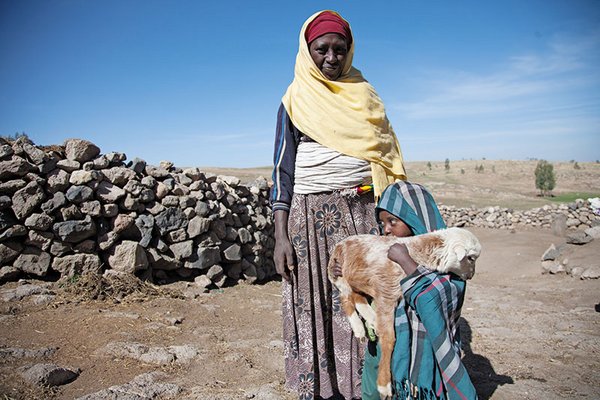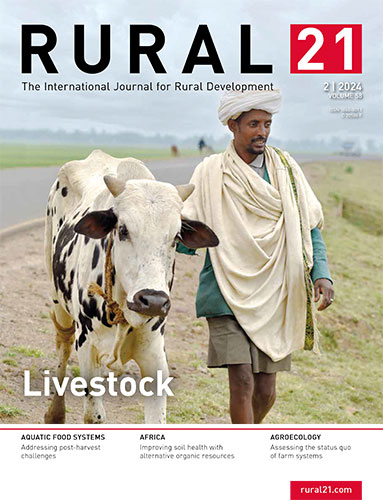 Download this article in magazine layout
Download this article in magazine layout
- Share this article
- Subscribe to our newsletter
Livestock insurance – promise of a resilience-building tool for pastoral communities
Livestock plays a significant role in most rural livelihoods in the Global South, as it is a source of income and employment, as well as being a social security net for the poor, especially for women, and pastoral communities in general, while being a source of nourishment to both urban and rural population. However, livestock is also most vulnerable to climatic shocks and associated effects that come with it. This in turn adversely affects the communities depending on it for livelihoods, social protection, food, income among others, making households, communities and economies themselves extremely vulnerable, and pushing them into poverty traps and marginalisation. Livestock insurance can be an effective tool to help reduce such vulnerability of both women and men, households and enterprises, especially since more than one billion people dependent on livestock face multiple climate hazards. This becomes more critical as only a fraction of climate investment is allocated to the development of livestock-based systems.
Two types of insurance schemes
Specifically for livestock, two types of insurance products exist: i) conventional indemnity-based insurance and ii) index-based insurance. Conventional indemnity insurance centres on actual loss and damage, with a farmer or livestock keeper being compensated for the loss of the animal because of disease, predator attack and/or theft. Such schemes are mainly applicable in mixed crop-livestock and/or dairy systems. Index-based insurance relates to weather or vegetation indicators and is particularly suitable for extensive systems such as pastoral areas which are home to nomadic and semi-sedentary livestock keepers and herders. Taking the specific example of index-based livestock insurance, such products have been specifically designed to protect pastoralists in the face of drought. The index in this case is the forage available, which, when it falls below a pre-defined threshold, triggers pay-outs which increase in proportion to the severity of estimated forage scarcity. This assumes that, when forage is scarce, grazing resources are depleted quickly, leading to deteriorating livestock conditions and increased livestock mortality. Thus, pastoralists could use the pay-outs to make production decisions that reduce their herd losses during the drought, including purchasing animal fodder, water or veterinary services. The index is derived by the Normalized Difference Vegetation Indices (NDVI) data.
Index insurance is advantageous for several reasons. Because pay-outs are not based on farm-level damages but on an objective index, transaction costs are reduced and moral hazard and adverse selection, which plague indemnity-based insurance, are minimised. Low administration costs can reduce insurance premiums, increasing affordability of the policy for smallholders and pastoralists. In addition, because insurance is based on reliable and independently verifiable information, re-insurance is relatively straightforward, and insurance companies can transfer part of the risk to international markets. Over the past years, the International Livestock Research Institute (ILRI) has developed such an insurance system together with partners. The index-based livestock insurance (IBLI) implementation model has had the private sector (insurance companies) at the forefront of offering the product to the clients (in this case the pastoralists), with ILRI’s role being the research for development partners responding to the needs of both demand and supply. In addition, ILRI has acted as a broker getting different actors (academia, private, public, implementation and humanitarian, among others) together for better market and capacity development, adoption and scaling in the rangelands of East Africa.
Impacts at household and community level
In order to understand the impacts of index-based livestock insurance on the behavioural changes and welfare benefits at household and community level, a panel was set up in both Kenya and Ethiopia where household data were collected on various welfare indicators. It was found that during drought, households with IBLI coverage have higher incomes and milk production, are 27–36 per cent less likely to skip meals and 22–36 per cent less likely to sell livestock – a practice known as distress selling because this is a period when prices are lowest. Moreover, IBLI coverage increases investments in livestock as a productive asset. A study in Kenya found that over three years of IBLI coverage, average veterinary expenditures doubled, and livestock sales in non-drought years increased by an average 46 per cent. These and other changes to production strategies among the insured seem to pay off, increasing the milk productivity of livestock and the total value of milk produced. Positive impacts on other indicators of well-being were also observed, including greater household income per adult equivalent and improvements in mid-upper-arm circumference (MUAC), a strong predictor of child malnutrition. Even in the absence of severe drought or indemnity payments, IBLI was shown to improve purchasers’ well-being by providing ease of mind. Furthermore, a study in Ethiopia indicated that women were purchasing insurance at higher rates than men, while a study in Kenya showed that women tended to have better access to credit if they were IBLI policy holders. Uptake of index insurance has also been found to improve education outcomes.
The evidence presented clearly demonstrates that products such IBLI play a critical role in coping with climatic shocks such as droughts. Adoption of the technology as a social safety net programme by the Government of Kenya and the World Food Programme in Ethiopia suggest that it can be an effective instrument in resilience-building. However, challenges remain on several fronts, which also provides opportunities for innovation, research and testing new business models for uptake and scaling. Some of these challenges encountered have been around low uptake, varied understanding of insurance products and high loss ratios by the insurance companies in the wake of massive payouts because of frequent and intense shocks, such as the recent prolonged droughts of 2021–2022 experienced in the Horn of Africa.
Some bottlenecks
In the rangelands, over time, pastoralists have used traditional ways of community insurance, such as helping their community with animals in the event of a loss, sharing resources amongst themselves when in need. However, when it comes to financial services such as livestock insurance, the communities want to see the immediate and tangible benefits of the same. Moreover, in the rangelands, the complexity and fragility of the contexts often lead to shifting priorities among individuals and the community, which in turn result in low uptake and use of insurance schemes. In such contexts, especially with the impacts of climate change being felt in multiple directions, insurance needs to be provided with other services to be viable and encourage uptake by livestock keepers. This also leads to the point of understanding how these schemes work, and to the recognition that they are neither a savings account or fixed deposits nor a lottery ticket. Often, while offering products such as livestock insurance in the rangelands, misinformation about the product and the purpose it is supposed to serve may lead to an initial surge in uptake, but quickly decline once the reality of what the product can and cannot do comes to light. In addition, complexity of insurance products, basis risk and the limited capacity of the suppliers to ensure last-mile delivery are some of the bottlenecks that prevent smallholder farmers and livestock herders from using the insurance products.
One issue which often goes unnoticed is around targeting and not paying attention to the fact that gender roles are critical in the pastoral areas. Right from the type of livestock ownership to access to resources and services, insurance is often treated in a binary fashion, i.e. assuming that men and women have similar needs and preferences for insurance. Typically, in the pastoral settings large livestock types like cattle and camels are owned by men and the small ruminants and poultry by the women. Recent work done by ILRI in collaboration with partners have shown that there is significant difference in income expenditure between men and women during shocks and normal periods and also access to markets depending on the type of livestock in question. In addition, studies are showing that if insurance products are centred around households, this attracts more women to take up the products; one example here has been reframing the livestock insurance to family insurance, showing that women were more responsive to purchasing the product.
The next steps
Any market-driven financial and non-financial service has to be gender responsive, socially inclusive and embedded within local, regional and/or national institutional mechanisms. Capacity development sits at the heart of uptake and scaling of insurance products as stronger delivery mechanisms also enable market development and private investment attraction. This requires innovations in delivering as well as offering these services based on need and demand in the pastoral communities, which in turn means investing in intensive market research, extension and education for demand-driven products and in offering complementary services, along with developing and understanding inputs and services markets in these fragile, complex and dynamic contexts.
Going forward, capacity enhancement and development together with advocacy for enabling environment for up-scaling and out-scaling of the risk management solutions such as livestock insurance continues to be at the heart of ILRI’s agenda. This includes research questions on the relationship between livestock insurance products in conflict mitigation and peace-building in fragile systems and also the role that livestock insurance products like IBLI can play in strengthening graduation programmes through coupling asset building with asset protection. Anchored on the legacy of the index-based livestock insurance, ILRI will continue to work on risk management solutions which are not just limited to financial services but represent a comprehensive approach to de-risking, taking into account processes, practices and social differentiation for providing effective tools for strengthening systems and building resilience in the rangelands and the pastoral communities in the Global South.
Rupsha R Banerjee is a Senior Scientist at the International Livestock Research Institute (ILRI) based in Nairobi, Kenya. She currently leads an agenda for scaling-out risk management solutions for livestock, including the use of digital information for service delivery in the Horn of Africa. Rupsha holds a PhD in Science Technology and Cognition from the University of Bologna, Italy. Contact: b.rupsha@cgiar.org
Kelvin Shikuku is a Senior Scientist at ILRI and leads research in behavioural change and social learning with a focus on the drylands in the Horn of Africa. He holds a PhD in Development Economics from Wageningen University, Netherlands.
References:
M. Herrero, D. Grace, J. Njuki, N. Johnson, D. Enahoro, S. Silvestri and M. C. Rufino. 2013. The roles of livestock in developing countries. Cambridge University Press.
Janzen, S. A., and M. R. Carter. 2018. “After the Drought: The Impact of Microinsurance on Consumption Smoothing and Asset Protection.” American Journal of Agricultural Economics 101 (3): 651–71.
Jensen, N. D., C. B. Barrett, and A. G. Mude. 2017. “Cash Transfers and Index Insurance: A Comparative Impact Analysis from Northern Kenya.” Journal of Development Economics 129 (November): 14–28.
Tafere, K., C. B. Barrett, and E. Lentz. 2018. “Insuring Well-Being? Buyer’s Remorse and Peace of Mind Effects from Insurance.” American Journal of Agricultural Economics 101 (3): 627–50.
Bageant, E. R., and C. B. Barrett. 2017. “Are There Gender Differences in Demand for Index-Based Livestock Insurance?” The Journal of Development Studies 53 (6): 932–52.
Gesare, A., M. Sheahan, R. Banerjee, and A. Mude. 2016. “Determinants of Pastoral Women’s Demand for Credit: Evidence from Northern Kenya.” Working Paper (unpublished)
Taye, M., Alulu, V., Gobu, W and Jensen, N. 2019. Livestock insurance payouts and coping strategies of pastoralists during drought. Research Brief # 90




